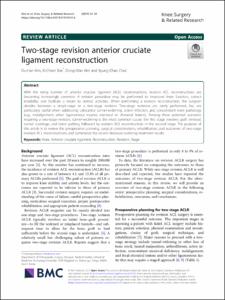KUMEL Repository
1. Journal Papers (연구논문)
1. School of Medicine (의과대학)
Dept. of Orthopedic Surgery (정형외과학)
Two-stage revision anterior cruciate ligament reconstruction
- Keimyung Author(s)
- Kim, Du Han; Bae, Ki Cheor; Kim, Dong-Wan
- Department
- Dept. of Orthopedic Surgery (정형외과학)
- Journal Title
- Knee Surgery and Related Research
- Issued Date
- 2019
- Volume
- 00
- Issue
- 0
- Keyword
- Knee; Anterior cruciate ligament; Reconstruction; Revision; Stage
- Abstract
- With the rising number of anterior cruciate ligament (ACL) reconstructions, revision ACL reconstructions are becoming increasingly common. A revision procedure may be performed to improved knee function, correct instability, and facilitate a return to normal activities. When performing a revision reconstruction, the surgeon decides between a single-stage or a two-stage revision. Two-stage revisions are rarely performed, but are particularly useful when addressing substantial tunnel-widening, active infection, and concomitant knee pathology (e.g., malalignment, other ligamentous injuries, meniscal or chondral lesions). Among these potential scenarios requiring a two-stage revision, tunnel-widening is the most common cause; the first stage involves graft removal, tunnel curettage, and bone grafting, followed by revision ACL reconstruction in the second stage. The purpose of this article is to review the preoperative planning, surgical considerations, rehabilitation, and outcomes of two-stage revision ACL reconstructions and summarize the recent literature outlining treatment results.
- Publisher
- School of Medicine (의과대학)
- Citation
- Du-Han Kim et al. (2019). Two-stage revision anterior cruciate ligament reconstruction. Knee Surgery and Related Research, 00(0), 10–10. doi: 10.1186/s43019-019-0010-6
- Type
- Article
- ISSN
- 2234-2451
- Source
- https://kneesurgrelatres.biomedcentral.com/articles/10.1186/s43019-019-0010-6
- Appears in Collections:
- 1. School of Medicine (의과대학) > Dept. of Orthopedic Surgery (정형외과학)
- 파일 목록
-
-
Download
 oak-2019-0412.pdf
기타 데이터 / 1.68 MB / Adobe PDF
oak-2019-0412.pdf
기타 데이터 / 1.68 MB / Adobe PDF
-
Items in Repository are protected by copyright, with all rights reserved, unless otherwise indicated.